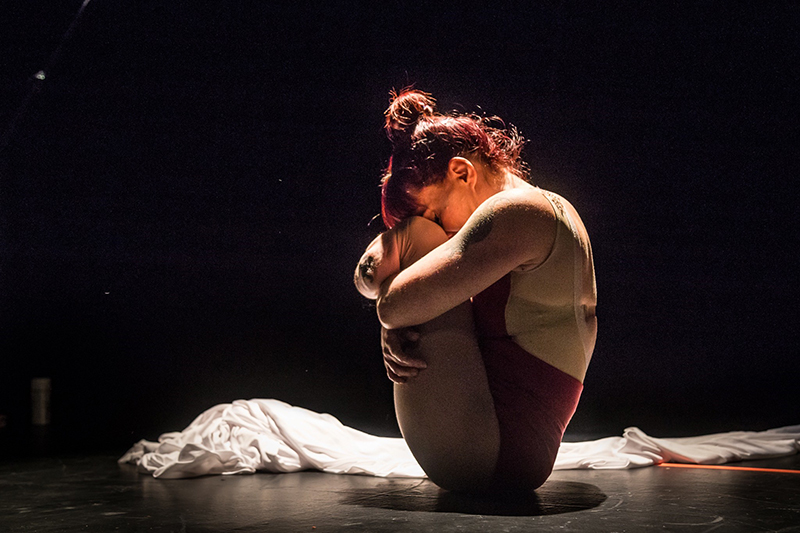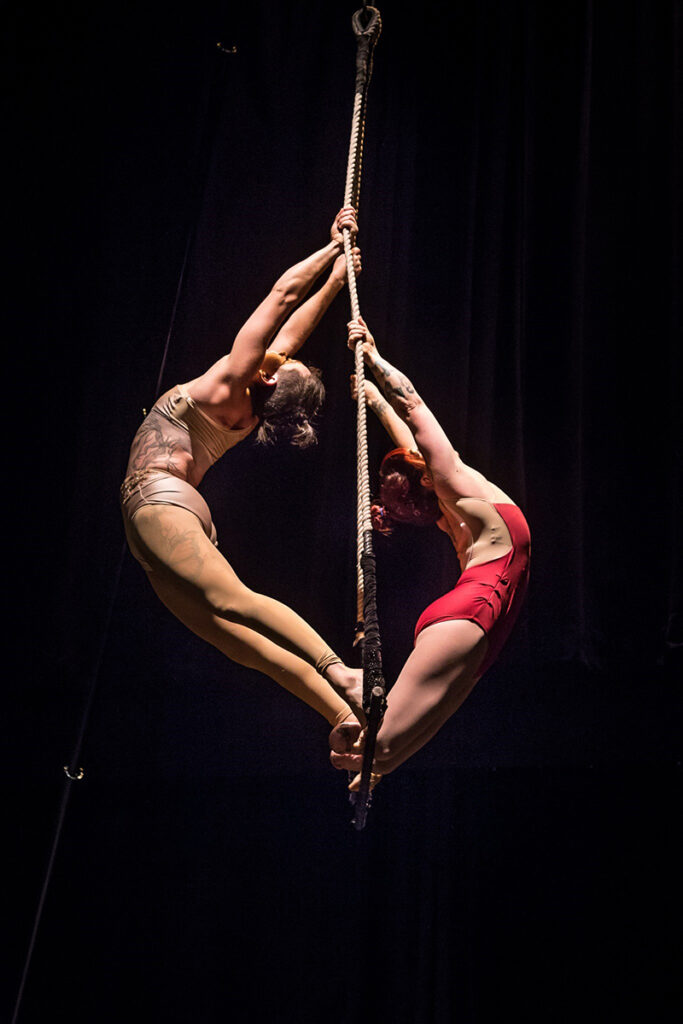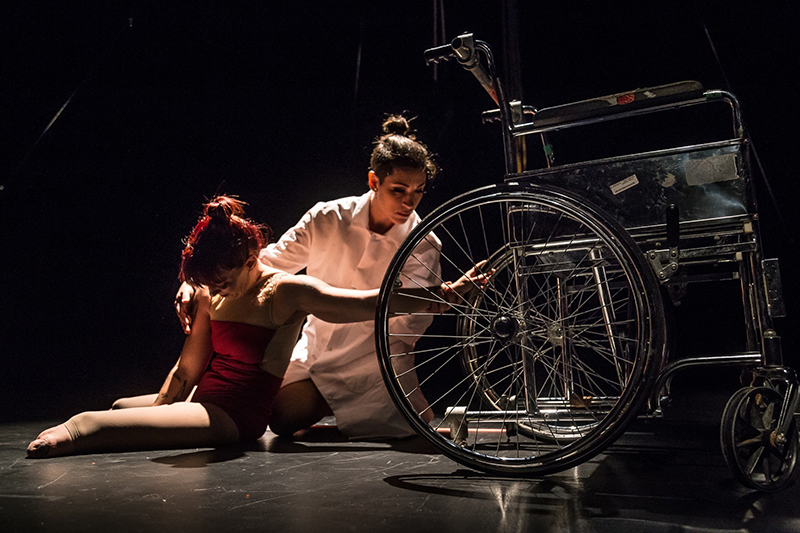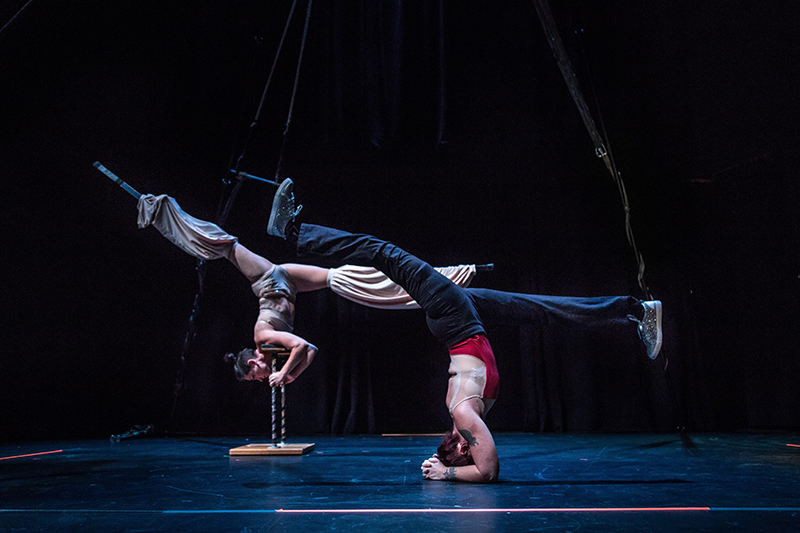Circus Centering Disability
An Interview with LEGacy Circus members Erin Ball, Vanessa Furlong, and April Hubbard
BY EMMALY WIEDERHOLT
Translated by Soo Jung Bae
Photos by Grim Photography
한글로 인터뷰를 읽으시길 원하신다면 스크롤을 내려주세요.
Erin Ball and Vanessa Furlong are the Canadian duo behind LEGacy Circus, which performs contemporary circus arts with the use of leg attachments, mobility aids, and traditional and non-traditional circus apparatuses. Along with their colleague April Hubbard, they performed The World at Our Feet at the 2022 Korea International Accessible Dance Festival. Here, they share how they connected and started creating circus centering disability, as well as the creative process behind The World at Our Feet.
This interview is part of a series of interviews with presenters and performers at KIADA 2022.

~~
Can you share a little about your dance or movement history and what shaped who you are as artists?
Vanessa: I started learning circus arts in 2006 and started performing professionally in 2012. My background is in theater, specifically physical theater, mime, and clown. From there, I learned about contemporary circus.
Erin: I am a circus artist and a double below knee amputee. I am white, queer, and neurodivergent. I discovered circus arts almost 15 years ago. In 2014, I joined the disability club as a double below knee amputee and noticed a gap in my own knowledge in the circus industry and movement-based practices in general about how to work with and welcome disabled folks. My practice since that time has been structured around how to welcome disabled people into classes, processes, performances, etc. (as artists, audiences, and techs). I try to center creative access at the core of my work whether that is as a coach, as a performer, or as an accessibility consultant. The majority of my work is about community and collaboration.
April: I was traditionally trained as an actor in theater. When I became more visibly disabled at the age of 16, it was made very clear there was not a space for me, so I moved into arts admin. In 2018, I was invited by Erin and Vanessa to participate in a training class for circus teachers on how to work with atypical bodies. I got to play on circus apparatuses and fell in love. I’ve been working with LEGacy ever since.
How would you generally describe LEGacy’s work to someone unfamiliar with it?
April: For me, I see LEGacy as a way of welcoming every type of body into movement, as well as finding a way to tell stories and challenge the status quo. LEGacy also prioritizes access for everybody – both the audience and performers. We think at every step of the process about how everyone is included and how we communicate our message in different ways. That could be enhanced narration for blind and partially sighted people, or ASL interpretation, or prioritizing venues that have wheelchair access. We make sure that if anyone wants to see the show, they can.
Erin: We’re striving to include everyone, as it’s not possible to include everyone. We strive to do our best.
Can you share a little bit about LEGacy Circus’ history? How did it get started?
Vanessa: Erin and I met in 2016. We met at a residency that brought together about a dozen circus performers from all over the world. Erin and I were encouraged to try making a piece together. At the time I was doing acrobatic stilts, so both of us were making use of different leg attachments. That exploration is what started the process to seek out creative ways for people to perform and receive the performance.
How did you get involved with or introduced to KIADA?
Erin: Through Instagram. They reached out to us a number of years ago. We couldn’t attend the festival at that point, but we kept in touch via “likes” over the years, and they reached out again and invited us to come for the 2022 festival.
What was your choreographic process creating The World at Our Feet, the piece you created for KIADA 2022?
Erin: The leg exploration between me and Vanessa started the creative and choreographic process. As we learned and explored more, we started prioritizing access and how that can lead and influence work. We were working from a place of asking questions about how access serves this work and how it functions for us as artists and also for audiences. We looked at exploring circus in nontraditional ways and prioritizing what we need as opposed to doing what’s usually done. And within that, we explored altering apparatuses as opposed to altering our bodies to suite the apparatuses.

Vanessa: Because we didn’t train together, we first needed to analyze our movement vocabulary and what came about when we were together and playing on different apparatuses. We did work with some other circus trainers to see what possibilities are out there. During that process, we taught the trainers more than they taught us. It was frustrating at times because we did want outside input. We had some folks who gave us dramaturgical insight. That came much later once we had the shared vocabulary.
Erin is based in Ontario, and I am in Nova Scotia. That separation made it so that we needed a grant to come together as often as we wanted to in order to explore. We were fortunate to receive some grants. On top of that, there was the pandemic, which gave us a forced separation. We were supported by Summer Works Toronto with a residency where we explored how we could create a duo while apart. In circus, a duo requires counterbalancing and weight. It’s been an interesting process to find out how access doesn’t only refer to disability but also accessing each other. Technologies out of the pandemic have made that exploration possible.
April: As someone who has been lucky enough to observe the creation process between Erin and Vanessa, I want to share how they recognize that everyone has their own expertise to bring to this. They bring in other folks to guide them in the creation process. Whenever I work with them, I feel honored to be heard and listened to. It’s a very collaborative effort.
From your perspective, what opportunities are there for circus arts performers with disabilities in your own communities?
Erin: Currently, circus is becoming more accessible. My experience in 2015 after my accident was that there were not a lot of opportunities, and if there were opportunities, they were not very accessible because they felt like ticking a box and were tokenistic. Part of the impetus behind LEGacy Cirus is giving ourselves access. I also opened a space in Ontario called Kingston Circus Arts that offers courses for instructors on how to dismantle ableism. Kingston Circus Arts is a space that strives for inclusion and accessibility in classes and is disability-led. As a solo project, I created a course for movement-based instructors that strives to dismantle ableism in movement-based practices. I teach the course internationally.
Vanessa: In terms of my community in Nova Scotia, the only self-identifying disabled circus artists are myself and April. We’re being invited to perform at dance and theater festivals, and in some cases at corporate events. It’s still niche. There is a school in Halifax that is working toward creating more programming. The opportunities are technically there, but it’s still niche.
April: In my experience in Halifax, I came into this movement-based practice through Erin and Vanessa, which was really unique and welcoming. When I started to try to take additional courses, I felt unwelcomed as someone with a visible disability. They didn’t understand how to train my body. There’s still not the knowledge of how to keep me safe and make me feel welcomed.
Is there anything you took from your experience at KIADA that will inform your work or that you will share with your community?
Erin: I loved meeting people from all over the world and witnessing bodies like mine on stage. It was a great reminder to keep advocating and keep creating because representation is so important.
How would you like to grow or expand your work in the future?
Vanessa: Because we spent so much time on pause because of the pandemic, all I know is I want there to be next steps. There’s so much unlearning and learning that has gone on during the past few years with regards to disability justice. I need that to better understand and inform my own contribution to LEGacy Circus. I hope to travel and tour more, as well as build upon the pieces we have. But beyond that, I don’t know yet.
~~
To learn more, visit legacycircus.com. Follow Erin @erinballcircus, Vanessa @vanessa_bobessa, and April @strongeronwheels on Instagram.

~~
장애를 중심으로 하는 서커스
레거시 서커스(LEGacy Circus)의 멤버 에린 볼(Erin Ball), 바네사 펄롱(Vanessa Furlong), 에이프릴 허바드(April Hubbard)와의 인터뷰
에말리 위더홀트(Emmaly Wiederholt) 작성
배수정 번역
사진 촬영: 그림(Grim)
에린 볼(Erin Ball)과 바네사 펄롱(Vanessa Furlong)은 캐나다에서 다리 부착 장치와 이동 보조기, 전통적 · 비전통적 서커스 기구들을 기반으로 현대 서커스 예술 공연을 하는 듀오입니다. 에린과 바네사는 동료 에이프릴 허바드(April Hubbard)와 함께 대한민국 장애인 국제 무용제(키아다, KIADA) 2022에서 작품 <우리 발 아래의 세상>을 선보였습니다. 본 인터뷰에서는 에린과 바네사, 에이프릴이 장애와 서커스를 어떻게 연결하는지, 어떻게 장애를 중심으로 서커스를 만드는지, 또 작품 <우리 발 아래 세상>이 탄생한 과정에 대해 공유하고자 합니다.
본 인터뷰는 키아다 2022에서 공연을 한 무용수들과 안무가들의 인터뷰 모음집의 일부입니다.
~~
무용을 해 온 경험에 대해, 또 본인을 무용가로 만들어 준 배경에 대해 설명해주실 수 있나요?
바네사: 저는 2006년에 처음 서커스 예술에 대해 배우기 시작했고, 2012년에 전문적으로 공연을 하기 시작했습니다. 저는 연극을 공부했고, 그 중에서도 신체적인 연극, 마임, 광대를 집중적으로 공부했습니다. 거기서부터 현대 서커스를 배우게 되었습니다.
에린: 저는 서커스 예술가이고, 두 다리 모두 무릎 아래로 의족을 갖고 있습니다. 저는 백인이고, 퀴어이고, 신경 다양성(뉴로 다이버전트)을 가지고 있습니다. 저는 거의 15년 전쯤 서커스 예술을 알게 되었습니다. 2014년에 저는 두 다리 모두 의족을 사용하는 장애인 모임에 참여했습니다. 그 모임에 참여하면서 저는 서커스 산업 및 움직임 기반 활동들의 지식과 제가 가진 지식 사이에 어떤 차이가 존재한다는 것을 깨달았습니다. 장애를 가진 사람들을 어떻게 환대할 것이고, 어떻게 함께 작업을 할 것인지에 대한 앎에 있어서요. 그때부터 저는 강의 및 커리큘럼, 공연(예술가로서,관객으로서, 또 기술로서)에 장애인들을 어떻게 환대할것인지를 중심으로 삼으며 활동을 해왔습니다. 코치로서든, 공연자로서든, 접근 가능성&통합 가능성 상담가로서든, 저는 ‘창의적인 접근’을 제 작업의 핵심으로 삼고자 합니다. 제 작업의 대부분은 공동체와 협업에 관한 것입니다.
에이프릴: 저는 원래 연극 배우로 교육을 받았습니다. 열 여섯 살 때 제 장애가 좀 더 가시화되면서, 제가 설 수 있는 입지가 없다는 것을 느꼈고, 분야를 예술 행정으로 바꾸게 되었어요. 2018년에 저는 에린과 바네사의 초대를 받아 서커스 선생님들을 대상으로 하는 교육 강좌에 참여했습니다. 비전형적인 몸과 함께 작업하는 것을 가르치는 수업이었어요. 거기서 저는 서커스 기구를 접했고 완전히 매료되었죠. 그 때부터 저는 레거시 서커스와 함께 작업을 하게 되었습니다.
레거시 서커스를 잘 모르는 사람들을 위해서, 레거시 서커스를 설명한다면 어떻게 표현하실 수 있을 것 같나요?
에이프릴: 저에게 레거시 서커스는 어떤 유형의 몸도 움직임 안으로 환영하는 방식이에요. 이야기를 할 방법을 찾는 것, 그리고 현재의 상황에 도전할 방법을 찾는 것과 함께요. 또 레거시 서커스는 모두의 접근성을 최우선으로 하죠 – 관객과 공연자 모두에게요. 저희는 과정의 매 단계마다 어떻게 모두를 포함시킬지, 또 저희의 메세지를 어떻게 다른 방식으로 전달할 수 있을지에 대해 고민합니다. 시각장애를 가진 분들을 위한 나레이션일 수도 있고, 수어 통역일 수도 있고, 휠체어 접근이 가능한 좌석을 우선시하는 것일 수도 있습니다. 공연을 보고 싶은 사람이라면 누구든지 볼 수 있도록 합니다.
에린: 모두를 포함시키는 것이 어렵기 때문에, 더더욱 모두를 포함시키기 위해 최선을 다해 노력하고 있습니다.
레거시 서커스의 역사에 대해 이야기를 해주실 수 있나요? 처음 시작하게 된 계기는 무엇이었나요?
바네사: 에린과 저는 2016년에 만났습니다. 전 세계의 서커스 공연가들이 모였던 레지던시에서 만났죠. 거기서 에린과 저는 함께 작품을 만드는 것을 시도해 보도록 격려를 받았어요. 당시에 저는 곡예 죽마를 하고 있었기 때문에 저희는 둘 다 서로 다른 다리 부착 장치를 이용하고 있었죠. 탐험과도 같았던 당시의 경험이 저희가 사람들을 위해 공연을 하고, 또 공연을 받는 창의적인 방법을 찾아나가게 된 과정의 출발점이었습니다.
어떻게 KIADA와 함께하게 되었나요?
에린: 인스타그램을 통해서요. 키아다는 몇 년 전에 저희에게 연락을 했습니다. 당시에는 저희가 무용제에 참가할 수 없었지만, 몇 년간 “좋아요”를 통해 계속 연락을 이어왔고, 키아다로부터 다시 연락을 받았습니다. 그래서 2022년 무용제에 초대 받아 오게 되었습니다.
키아다 공연을 위해 만든 작품 <우리 발 아래의 세상>의 무용 작업을 하는 과정은 어땠나요?
에린: 저와 바네사가 각각 다리에 대한 탐구를 하는 것이 창의적인 무용 작업의 출발점이 되었습니다. 저희가 더 알아가고 배워갈수록, 접근성을 우선시하기 시작했습니다. 또 그것이 어떻게 작업으로까지 이어지고, 영향을 미칠 수 있는지를 고민했죠. 접근성이 어떻게 이 작품에 기여할 수 있는지를 질문했습니다. 또 공연자인 저희와 관객들에게 접근성이 어떻게 기능하는지 물으면서 작업을 했습니다. 비전통적인 방식의 서커스를 알아보았고, 또 여태까지 많이 이루어졌던 작업이 아니라 저희가 필요로 하는 것을 더 중시했습니다. 그리고 그 안에서 기구에 맞게 저희 몸을 변형시키는 것이 아니라 기구를 저희 몸에 맞게 변형시키는 방식을 탐구했습니다.
바네사: 저희가 같이 훈련을 한 것이 아니기 때문에, 우선은 (라벨처럼) 저희의 움직임에 이름 붙일 용어에 대해 분석할 필요가 있었습니다. 또 저희가 함께할 때, 그리고 서로 다른 기구를 사용할 때 일어나는 것들에 대한 이해도 필요했습니다. 어떤 가능성들이 있는지 알아보기 위해 다른 서커스 트레이너들과 함께 작업을 하기도 했죠. 그 과정에서 트레이너가 저희를 가르친 것보다도 저희가 트레이너들을 더 많이 가르쳤습니다. 외부의 어떤 자극을 원했기 때문에 때로는 힘들었습니다. 몇몇의 트레이너들은 저희에게 연극적인 인사이트를 주기도 했습니다. 그건 저희가 공유된 용어를 갖고 난 한참 이후였어요.
에린은 온타리오를 기반으로 하고 있고, 저는 노바 스코샤에 있습니다. 서로가 떨어져 있었기 때문에, 최대한 자주 만나서 이런 저런 탐구를 하기 위한 지원이 필요했습니다. 운이 좋게 저희는 지원금을 받을 수 있었어요. 거기에 더해 코로나 19가 지속되었기에 떨어져 있었어야 했습니다. 저희는 “Summer Works Toronto”로부터 전속 지원을 받아서, 떨어져 있으면서도 듀오 작업을 할 수 있는 방법을 알아보았습니다. 서커스에서 듀오는 무게와 상호 균형을 필요로 합니다. 접근성이 장애에만 적용되는 개념이 아니라, 서로에게 접근하는 것을 의미하기도 한다는 것을 알아가는 과정이 흥미로웠습니다. 펜데믹 시기 속에서도 기술이 그런 탐구를 가능하게 했습니다.
에이프릴: 제게는 에린과 바네사의 창작 과정을 관찰할 수 있는 소중한 기회가 있었습니다. 에린과 바네사는 이 창작 과정에 기여를 할 수 있는 전문 지식을 모두가 갖고 있음을 잘 인지하고 있습니다. 에린과 바네사는 다른 사람들을 데려오고, 창작 과정에서 그들이 에린과 바네사를 가이드할 수 있도록 합니다. 제가 에린과 바네사와 협업을 할 때마다 저는 제가 들려지고, 들어지는 것이 감사합니다. 작업 과정은 아주 협력적입니다.

선생님의 관점에서 봤을 때, 선생님의 공동체에는 장애를 가진 서커스 예술 공연자들에게 어떤 기회가 주어지나요?
에린: 현재로서 서커스는 더 접근 가능해지고 있습니다. 제가 사고를 겪고 난 이후인 2015년에 기회가 많지 않다는 것을 알았고, 기회가 주어져도 그다지 접근성이 높지 않다는 것을 느꼈습니다. 일회적이고, 형식적으로만 주어지고, 보여주기식인 것처럼 느껴졌기 때문입니다. 레거시 서커스의 동력 중 하나는 저희 스스로에게 접근성을 주는 것 입니다. 저는 온타리오에 “킹스턴 서커스 아트(Kingston Circus Arts)”라는 공간을 열었습니다. 강사들을 대상으로 비장애중심주의를 해체하는 방식에 대한 강의를 제공하는 곳입니다. “킹스턴 서커스 아트”는 장애인들이 이끌어 가는 공간이고, 수업에서 포용과 접근성을 위해 노력하는 곳입니다. 저는 움직임 기반 활동을 하면서, 움직임 기반 활동들의 비장애중심주의를 해체하기 위해 노력하는 강사들을 대상으로 하는 강좌를 개설해 솔로 프로젝트로 제공하고 있습니다. 이러한 강의를 국제적으로 가르치고 있습니다.
바네사: 노바 스코샤의 커뮤니티의 경우, 스스로를 장애인 서커스 예술가로 칭하는 사람은 저와 에이프릴뿐입니다. 저희는 무용제나 연극제, 때로는 기업 행사에서 공연을 할 수 있게 초청을 받습니다. 하지만 여전히 틈새와 같은 기회입니다. 할리팩스(Halifax)에는 더 많은 프로그램들을 만들려는 학교가 있습니다. 형식적인 기회는 존재하지만, 여전히 좁은 틈입니다.
에이프릴: 할리팩스에서의 제 경험을 생각하면, 저는 에린과 바네사를 통해서 움직임 기반 활동을 접하게 되었습니다. 이건 매우 드물고 또 소중한 일이었습니다. 가시적인 장애를 가진 사람으로서, 제가 더 추가적으로 수업을 들으려고 하면 제가 받아들여지지 않는다는 것을 느꼈습니다. 그들은 제 몸을 어떻게 가르쳐야 하는지 이해하지 못했습니다. 저를 어떻게 안전하게 할 것인지, 또 어떻게 제가 충분히 환영받는다고 느끼게 할 것인지에 대한 지식이 여전히 부재합니다.
키아다에서 경험한 것 중에 선생님의 작업에 반영하거나 선생님의 커뮤니티에 공유하고 싶으신 것이 있나요?
에린: 전 세계 다양한 사람들을 만나는 것이 정말 좋았고 저와 같은 몸을 무대에서 만날 수 있어서 기뻤습니다. 보여지는 것이 굉장히 중요하기 때문에, 지속적으로 창작을 하고 또 이러한 활동을 계속 지지해야 한다는 것을 되새겨준 기념비적인 것이었습니다.
앞으로 작업을 어떻게 확장시키고 싶으신가요? 미래 계획이 있으신가요?
바네사: 팬데믹으로 오랜 시간동안 멈춰왔기 때문에, 제가 아는 것은 그저 다음 스텝이 있기를 바란다는 것뿐입니다. 지난 몇 년간 장애 인권 및 정의를 둘러싸고 굉장히 많은 것을 배우고, 동시에 기존에 알았던 것들을 해체해 왔습니다. 레거시 서커스에 제가 기여한 것을 더 잘 이해하고, 또 알리기 위해 그런 것이 필요합니다. 더 많이 여행하고 투어도 더 많이 할 수 있기를 바라고, 동시에 저희가 만들어 온 작업들 위에 더 쌓을 수 있기를 바랍니다. 그 이상은 아직 잘 모르겠습니다.
~~
더 자세한 정보를 원하시면, legacycircus.com을 방문해주세요. 에린 @erinballcircus과 바네사 @vanessa_bobessa, 그리고 에이프릴 @strongeronwheels의 인스타그램을 팔로우해주세요.

One Response to “Circus Centering Disability”
Vanessa Furlong is also known as Ema the woman who stars in Girl Fight Videos on the website Ladyfist
Comments are closed.